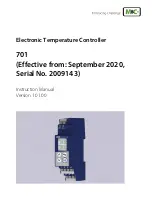
54
|
059063–00 REV. C
12
TROUBLESHOOTING
CONTROL OPERATION
TOO MUCH HEAT
Check if the control has any of the following conditions:
•
Domestic Hot Water call
—The SQ-Elite-8T will raise the temperature of the system to
either 200˚F or Maximum Target on a DHW call.
•
Reset Ratio and Offset
—If excessive heat occurs only in certain weather conditions,
adjust the Reset Ratio and Offset (See Understanding Operating Concept on page 6).
If excessive heat occurs year round, reduce the Offset.
•
Unit Mode Settings
—The SQ-Elite-8T will only sequence boilers with a Mode set to
Auto or Standby. Check to if any boiler stage is set to On.
•
Control Settings
—The Last Stage Hold will allow only the Lead boiler to exceed the set
point. If the setting is too high, and only the Lead boiler is on, the system can over heat.
Reduce the Last Stage Hold setting. This will mostly occur in mild weather.
TOO LITTLE HEAT
Check if the control has any of the following conditions:
•
Reset Ratio and Offset
—If reduced heat occurs only in certain weather conditions,
adjust the Reset Ratio and Offset (See Understanding Operating Concept on page 6).
If reduced heat occurs year round, increase the Offset.
•
Setback and Day/Night Schedule
—If reduced heat occurs only during specific hours,
check the Day/Night Schedule and the Setback, Boost, and Boost Period values. Either
reduce the Setback or Boost settings or change the Day and Night Schedules.
•
Boiler Mode Settings
—The SQ-Elite-8T will only modulate boilers their mode is set to
Auto or Standby. Check if any boiler stage is set to Manual, Off, or Standby.
UNITS ARE SHORT-CYCLING
•
Minimum Runtime
—Increase the Minimum Runtime only if all units tend to short-cycle.
•
Last Stage Hold
—Increase the Last Stage Hold only if the lead unit tends to short-cycle.
SYSTEM IS OVERSHOOTING OR UNDERSHOOTING
•
Reaction Time and Minimum Runtime
—If the system is overshooting or undershooting,
adjust Minimum Runtime or the Reaction Time. That depends on if the stages are
brought on fast and were not allowed to turn off until the Minimum Runtime elapsed.
Or, the stages were brought on slowly, however, were allowed to turn off quickly.
•
PID vs OSS
—If the application the system is used on requires fast response that the
normal PID mode cannot provide, try using the OSS mode and adjust the Throttle
Range according to the system requirements.
TEMPERATURE SENSOR CHART
TEMPERATURE
(IN DEGREES °F )
VALUE
(IN OHMS)
-30
117720
-20
82823
-10
59076
0
42683
10
31215
20
23089
25
19939
30
17264
35
14985
40
13040
45
11374
50
9944
55
8714
60
7653
70
5941
80
4649
90
3667
100
2914
110
2332
120
1879
130
1524
140
1243
150
1021
160
842
170
699
180
583
190
489
200
412
210
349
220
297
230
253
240
217
250
187











































